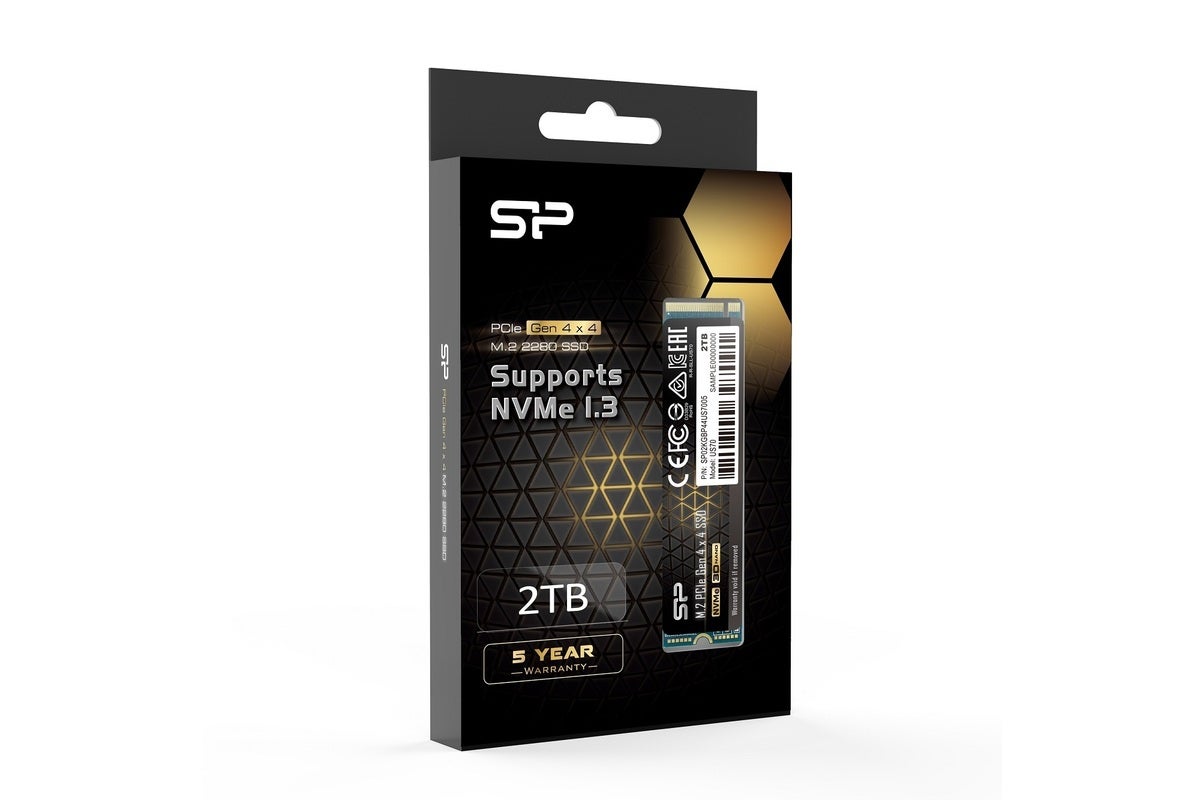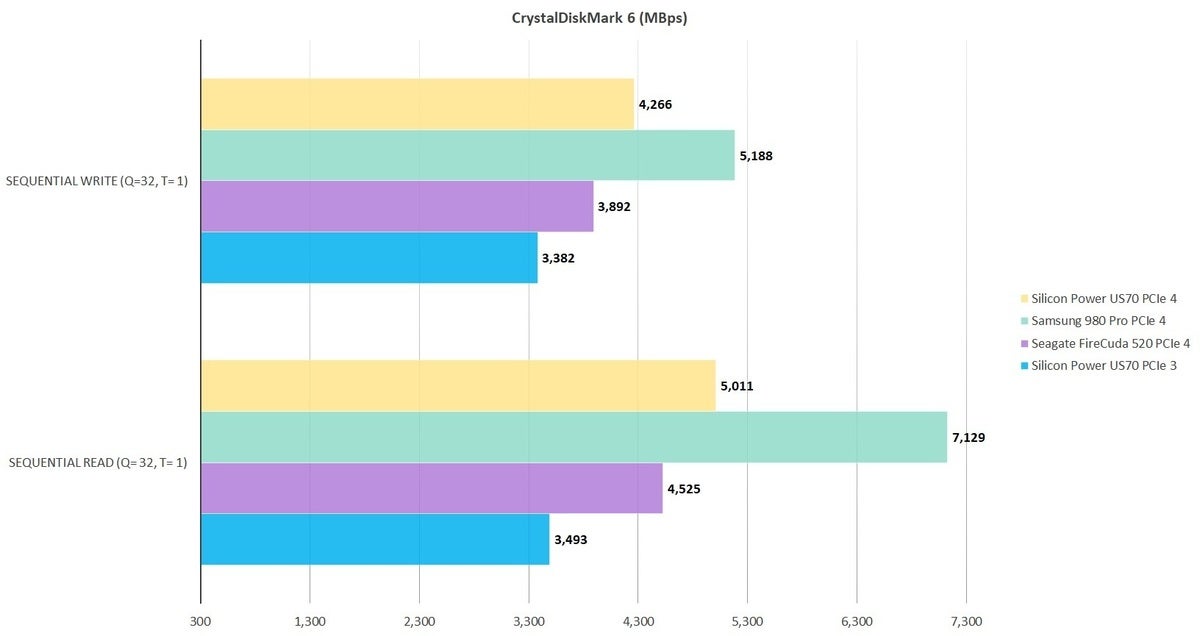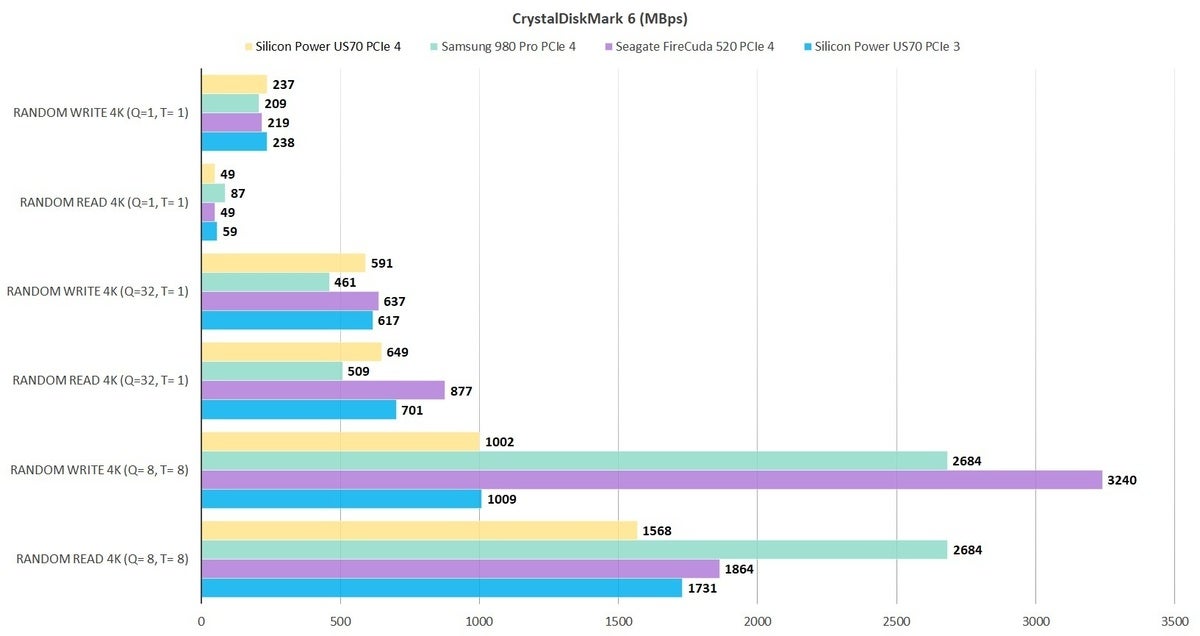 Credit: Silicon Power
Credit: Silicon Power
The US70 is our first look at a Silicon Power SSD, and we liked the view. It’s not a top-tier drive, but it’s not priced like it either, and our 2TB review unit turned some nice test scores. This drive is a solid value.
This review is part of our ongoing roundup of the best SSDs. Go there for information on competing products and how we tested them.
Design and features
The US70 is a mid-priced SSD in the usual 22mm-wide, 80mm-long, M.2 physical format. The connector is M.2, and it supports the PCIe 4.x that’s common on AMD systems and some newer Intel laptops and motherboards. The NAND is 96-layer TLC; up to a third will be treated as SLC for caching. There’s also 1GB of DRAM for every 1TB of capacity. The controller on the 2TB unit we tested is a Phison E16.
 Silicon Power
Silicon Power
Silicon Power’s retail box for the 2TB version of the US70 PCIe 4.x NVMe SSD.
The US70 was available at the time of this writing in two capacities: 1TB ($175 on Amazon) and the 2TB we tested ($320 on Amazon). The warranty period is five years, and the TBW (TeraBytes Written over the life of the drive) ratings are an extremely generous 1,800 for every 1TB of capacity.
What’s not guaranteed is that the SSD components will remain the same over time. Silicon Power retains the right to switch these as needs be, with the proviso that performance will meet what the company specifies in advertising. While this practice is common, some companies fall short in maintaining performance levels, as the story referenced above explains.
Performance
The US70 we tested is a very good performer—not record-setting, but fast enough for most users. Via PCIe 4 it actually bested the zippy Seagate FireCuda 520 in sequential throughput.
 IDG
IDG
The US70 turned in a fast performance under CrystalDiskMark 6. Longer bars are better.
It did quite well in our real-world 48GB transfers as well, though not on a par with the Samsung 980 Pro. Then again, the US70 is hardly alone in that regard.
 IDG
IDG
The US70 couldn’t match the Samsung 980 Pro in our real world transfers, but few drives do.
As a great deal of the difference between top-tier and lesser SSDs these days is in the queued, threaded small file performance, from here on in we’ll be including the CrystalDiskMark 4K numbers. As you can see below, the pricier drives come alive when more than one thread is involved.
 IDG
IDG
You can see here why you pay more for SSDs such as the Samsung 980 Pro and Seagate FireCuda 520. But that doesn’t make the US70 a dog, just a mid-range drive. Longer bars are better.
Our 450GB write test is simply to see how much secondary cache is allotted. When drives run out, this number will get longer in a hurry. We’ve seen as high as 17 or 18 minutes on some cheap NVMe SSDs.
 IDG
IDG
Shorter bars are better in our 450GB write test.
As the 2TB US70 we tested was empty and had approximately 666GB allotted as secondary cache, it never ran out during the 450GB test. The 1TB flavor would have 333GB of cache and would run out before the end. If it behaves like other similar Phison designs, write speed will drop to around 700MBps and post a time around 400-450 seconds. Both the Samsung 980 Pro and Seagate FireCuda 520 to which I’m comparing the US70 are 1TB SSDs, so keep that in mind if you’re shopping at the 1TB level.
The PCIe 3 tests utilized Windows 10 64-bit running on a Core i7-5820K/Asus X99 Deluxe system with four 16GB Kingston 2666MHz DDR4 modules, a Zotac (NVidia) GT 710 1GB x2 PCIe graphics card, and an Asmedia ASM2142 USB 3.1 card. It also contains a Gigabyte GC-Alpine Thunderbolt 3 card, and Softperfect Ramdisk 3.4.6 for the 48GB read and write tests.
The PCIe 4 testing was done on an MSI MEG X570 motherboard socketing an AMD Ryzen 7 3700X 8-core CPU, using the same Kingston DRAM, cards, and software. All testing is performed on an empty, or nearly empty drive. Performance will decrease as the drive fills up.
Note: As Silicon Power doesn’t guarantee that the drive you buy will have the components we tested, take our figures as ballpark. Run CrystalDiskMark 6 when you install the drive, and allow for your own system’s performance before drawing any conclusions.
Conclusion
This US70 is a very good NVMe SSD. It’s not going to give Samsung’s 980 Pro any worries, but it’s as fast overall as anything at a similar price and likely far faster than most users need. Just make sure yours performs as ours did when you get it home.
















